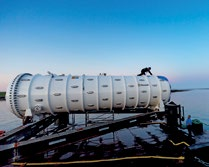Microsoft’s experimental datacenter lives under the water.


Microsoft’s experimental datacenter lives under the water.

Microsoft has recently deployed a datacenter in Scotland. There’s nothing unusual about that, except this datacenter was installed underwater, on the seafloor off the Orkney Islands.
The Northern Isles datacenter marks phase two of Microsoft’s Project Natick. The project is a years-long research effort looking into sustainable, prepackaged datacenter units, which can be deployed on the seafloor without maintenance.
Phase one, in 2016, tested a prototype that ran underwater for 105 days. Phase two’s Northern Isles datacenter is designed to operate under the sea for five years without maintenance. The 40-foot long container holds 12 racks with 864 servers. And it runs on clean energy; the datacenter gets its electricity from wind farms.

The most obvious reason for setting up datacenters in cold bodies of water is that they would be easy to cool. Servers generate a large amount of heat, and cooling them is expensive. It’s why companies like Facebook and Google have built data centers in near-arctic ground.
A less obvious reason to run a datacenter in the sea is that more than half of the world’s population lives near a coast. Datacenters near coastal cities would shorten the distance between server and client. The closer your smartphone or PC is to a server, the more likely it is you’ll get a faster, more stable connection.


The Project Natick team will spend the next year assessing the Northern Isles datacenter’s performance. Project Natick remains a research project, but it could one day lead to more clouds under the sea.
PICTURES MICROSOFT























